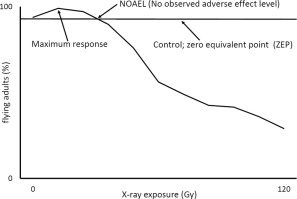当前位置:
X-MOL 学术
›
Comp. Biochem. Physiol. A Mol. Integr. Physiol.
›
论文详情
Our official English website, www.x-mol.net, welcomes your
feedback! (Note: you will need to create a separate account there.)
A dose of experimental hormesis: When mild stress protects and improves animal performance.
Comparative Biochemistry and Physiology A: Molecular & Integrative Physiology ( IF 2.1 ) Pub Date : 2020-01-16 , DOI: 10.1016/j.cbpa.2020.110658 Raymond Berry 1 , Giancarlo López-Martínez 2
Comparative Biochemistry and Physiology A: Molecular & Integrative Physiology ( IF 2.1 ) Pub Date : 2020-01-16 , DOI: 10.1016/j.cbpa.2020.110658 Raymond Berry 1 , Giancarlo López-Martínez 2
Affiliation

|
The adaptive response characterized by a biphasic curve is known as hormesis. In a hormesis framework, exposure to low doses leads to protective and beneficial responses while exposures to high doses are damaging and detrimental. Comparative physiologists have studied hormesis for over a century, but our understanding of hormesis is fragmented due to rifts in consensus and taxonomic-specific terminology. Hormesis has been and is currently known by multiple names; preconditioning, conditioning, pretreatment, cross tolerance, adaptive homeostasis, and rapid stress hardening (mostly low temperature: rapid cold hardening). These are the most common names used to describe adaptive stress responses in animals. These responses are mechanistically similar, while having stress-specific responses, but they all can fall under the umbrella of hormesis. Here we review how hormesis studies have revealed animal performance benefits in response to changes in oxygen, temperature, ionizing radiation, heavy metals, pesticides, dehydration, gravity, and crowding. And how almost universally, hormetic responses are characterized by increases in performance that include either increases in reproduction, longevity, or both. And while the field can benefit from additional mechanistic work, we know that many of these responses are rooted in increases of antioxidants and oxidative stress protective mechanisms; including heat shock proteins. There is a clear, yet not fully elucidated, overlap between hormesis and the preparation for oxidative stress theory; which predicts part of the responses associated with hormesis. We discuss this, and the need for additional work into animal hormetic effects particularly focusing on the cost of hormesis.
中文翻译:

一定剂量的实验毒物兴奋效应:当轻微的应激可以保护并提高动物的表现时。
以双相曲线为特征的适应性反应称为毒物兴奋效应。在毒物兴奋效应框架中,暴露于低剂量会导致保护性和有益的反应,而暴露于高剂量则具有破坏性和有害性。比较生理学家研究毒物兴奋作用一个多世纪了,但由于共识和分类学特定术语之间的分歧,我们对毒物兴奋作用的理解是支离破碎的。毒物兴奋效应过去和现在都有多个名称。预处理、调节、预处理、交叉耐受、适应性稳态和快速应力硬化(大多是低温:快速冷硬化)。这些是用于描述动物适应性应激反应的最常见名称。这些反应在机制上是相似的,同时具有应激特异性反应,但它们都可以属于毒物兴奋效应的范畴。在这里,我们回顾了毒物兴奋效应研究如何揭示动物对氧气、温度、电离辐射、重金属、杀虫剂、脱水、重力和拥挤的变化做出反应的性能益处。毒物兴奋反应几乎普遍地以性能的提高为特征,包括繁殖能力的提高、寿命的提高或两者兼而有之。虽然该领域可以从额外的机制工作中受益,但我们知道,其中许多反应都源于抗氧化剂和氧化应激保护机制的增加;包括热休克蛋白。毒物兴奋效应和氧化应激理论的准备之间存在明显但尚未完全阐明的重叠;它预测与毒物兴奋效应相关的部分反应。我们讨论了这一点,以及对动物毒物兴奋效应进行额外研究的必要性,特别是关注毒物兴奋作用的成本。
更新日期:2020-01-17
中文翻译:

一定剂量的实验毒物兴奋效应:当轻微的应激可以保护并提高动物的表现时。
以双相曲线为特征的适应性反应称为毒物兴奋效应。在毒物兴奋效应框架中,暴露于低剂量会导致保护性和有益的反应,而暴露于高剂量则具有破坏性和有害性。比较生理学家研究毒物兴奋作用一个多世纪了,但由于共识和分类学特定术语之间的分歧,我们对毒物兴奋作用的理解是支离破碎的。毒物兴奋效应过去和现在都有多个名称。预处理、调节、预处理、交叉耐受、适应性稳态和快速应力硬化(大多是低温:快速冷硬化)。这些是用于描述动物适应性应激反应的最常见名称。这些反应在机制上是相似的,同时具有应激特异性反应,但它们都可以属于毒物兴奋效应的范畴。在这里,我们回顾了毒物兴奋效应研究如何揭示动物对氧气、温度、电离辐射、重金属、杀虫剂、脱水、重力和拥挤的变化做出反应的性能益处。毒物兴奋反应几乎普遍地以性能的提高为特征,包括繁殖能力的提高、寿命的提高或两者兼而有之。虽然该领域可以从额外的机制工作中受益,但我们知道,其中许多反应都源于抗氧化剂和氧化应激保护机制的增加;包括热休克蛋白。毒物兴奋效应和氧化应激理论的准备之间存在明显但尚未完全阐明的重叠;它预测与毒物兴奋效应相关的部分反应。我们讨论了这一点,以及对动物毒物兴奋效应进行额外研究的必要性,特别是关注毒物兴奋作用的成本。











































 京公网安备 11010802027423号
京公网安备 11010802027423号